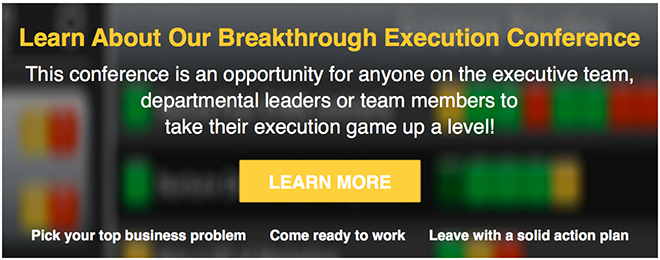If you have ever downloaded any tools or other resources on our site, you know that we usually ask  you about your Biggest Business Challenge in our forms. In response to your feedback, we are featuring a blog series on your biggest business challenges! This post is a response to the challenge “training and developing people."
you about your Biggest Business Challenge in our forms. In response to your feedback, we are featuring a blog series on your biggest business challenges! This post is a response to the challenge “training and developing people."
I chose to complete my Masters degree in Human Resources Development (adult learning/instructional design) because I thought training was “acting with a steady paycheck.” All I had to do was sharpen my facilitation skills, print out some snazzy colored transparencies (OOOOH) or add stock clipart to Powerpoint (AHHHH) and I was on my way to getting anyone in any organization properly trained. Hey, these were high tech tools in the 90’s!
Catapulting a few decades in the future, we now have: e-learning, in-app support, video conferencing, gamification and video tools as options in how to “get my people trained.”
I’ve played in most of the technologies and lived on both sides of the fence as one who designed and delivered training to the one determining training for my team, and I can share with you patterns of success. You may not be in the weeds creating the materials, but you may find these tips a way to guide those who do.
We hear “my team needs training” for many reasons: new processes or technology, changing roles, low performance, or just to hit the “# of training hours” KPI (key performance indicator). Training is the cure all, the savior and the one-time event to banish all errors and get things back on track. Bless my “acting with a steady paycheck” heart – this is not the case. In fact, when I’d observe the organization, roles, processes, systems and interview the problem children, I often found that training is not what’s really needed:
- Perhaps the Frankenstein monster of a ‘custom software’ you love so much is actually not user friendly, could use a redesign, pop-up help features, or be sent to its death.
- Maybe the processes your team is following are inherent with issues that cause slow performance or welcome human error.
- Have you considered the role may be ill defined, with unclear goals?
- And, if you need training just to fill your “butts in seats” KPI, you just need a new KPI.
Whether or not you’re trying to determine if training is needed, start here:
STEP 1 - Slow down before you speed up
Have a third-party observe and interview a representative sample of different levels of performers and longevity in the position to collect themes on pain points, best practices, and potential process gaps. If you uncover issues that are not remedied by training, stop here and face the elephant.
If you are introducing new processes or technology, this exercise is still the first step to determine what your team’s workflow is like today so the communication and learning can be properly tailored. Ideally, you would have already done step #1 before finalizing the new process or technology so you could properly fine-tune and configure. What’s that? I’m hard to hear up here on my soapbox?
STEP 2 - Identify your personas or audience
Don’t throw everyone into your 250-person capacity room just because you can. Determine whom your audiences are based on how they will interact with the process or technology. Some audiences will just need a high-level overview while others will require deeper practical knowledge and application. These personas and audiences are not always identified by title; therefore, they could be based on future role, level of interaction with the process or technology, skill level, or user type (remote, mobile, global, etc.).
STEP 3 - Go old school with learning objectives
Once I have my personas or audiences, I begin with the end in mind. What does each of these groups have to KNOW or DO at the end of the training program? I use the revised Bloom's Taxonomy to align where each audience is and write appropriate learning objectives for each. Does this audience need to remember, apply, analyze, etc.?
I thought I could get away without these pesky learning objectives in the past; but, I find they are a necessary means to truly tailoring both the content and the approach to each audience. I’ve rekindled my romance with Bloom.
Oh, one other thing, I don’t always share these objectives with the audience. I put them into more ‘agenda’ speak. We don’t want to start a section putting folks to sleep - just make sure they know where you’re taking them so they’ll relax and pay attention.
STEP 4 - Determine how to evaluate
Before I write content, I take the learning objective by audience and determine how I’ll know if they are successful. The higher up they are in Bloom’s Taxonomy, the more complex the assessments may be.
- If an audience needs to ‘remember,’ a multiple-choice test may be all they need.
- If another needs to apply the learning, they may need scenario-based questions or a scavenger hunt.
- To analyze, I’d create real-life problems and ask them to demonstrate how they would solve through observation and evaluation.
Create the assessment and evaluation before you get mired in content and death by slides.
STEP 5 - Design your One-Two Punch
We’ve come so far in technology, but I still find most of us learn best alongside our peers and in a safe place to ask questions. We also need more than one opportunity to hear a message, internalize it and ask questions.
- For on-demand videos or e-learning, consider human interactions as well. Try pairing e-learning or videos with live virtual Q&A sessions or office hours.
- If you’re taking the traditional classroom approach, I recommend holding lunch ’n’ learns, drop-in sessions or setting up 1:1s during weeks 1-3 after the formal training. Why? Your audience will stare blankly at you during the first pass until they have time to play with the new process or technology and actually think of questions. Be prepared in these follow up sessions with FAQs, best practices or scenarios to keep the conversation going.
STEP 6 - Train ‘em!
You have your approach and now you want to design your solution. Your learning objectives and assessments will guide you in what points to make.
- For face-to-face learning, consider hiring an experienced facilitator to ensure the right amount of energy and interaction. Pair the facilitator with someone from the business who can field those job-specific questions.
- For any end user facing materials, use mostly images and very little text.
- Tell stories! They’ll never remember slides 70-90 but, they’ll always remember your story and can more easily recall it for application.
- Leave them with a job aid and a support mechanism either through on-demand help or contact information. The job aid is the place where more wordy, step-by-step instructions would be most helpful rather than during the session itself.
STEP 7 - Do they get it?
Smile sheets on how the users liked the learning session are still useful in making quick decisions and adjustments on what is and what is not working. However, the facilitator may be full of energy and the food fantastic, but the needle may not move on productivity because the content wasn’t what is needed to be:
- For anything they need to KNOW, you’ve already created your assessment questions in Step 2. Check.
- For anything they need to DO, create other ways of measuring: ask a one question survey with a scale that asks if they are more productive today using X than Y?
- Follow up during your 1:1 session and ask them to demonstrate a task or navigate a system.
I went into the learning and development field thinking I’d bask in the spotlight upon a stage. I realize the power of great learning; however, the real power lies backstage with proper analysis, planning and developing a blended learning environment with substantial support mechanisms. That’s OK. All the cool people hang out backstage.
And….cut
Photo credit: Flickr User Mohammad Jangda, CC license
Photo Credit: iStock by Getty Images



 LinkedIn
LinkedIn
 Facebook
Facebook
